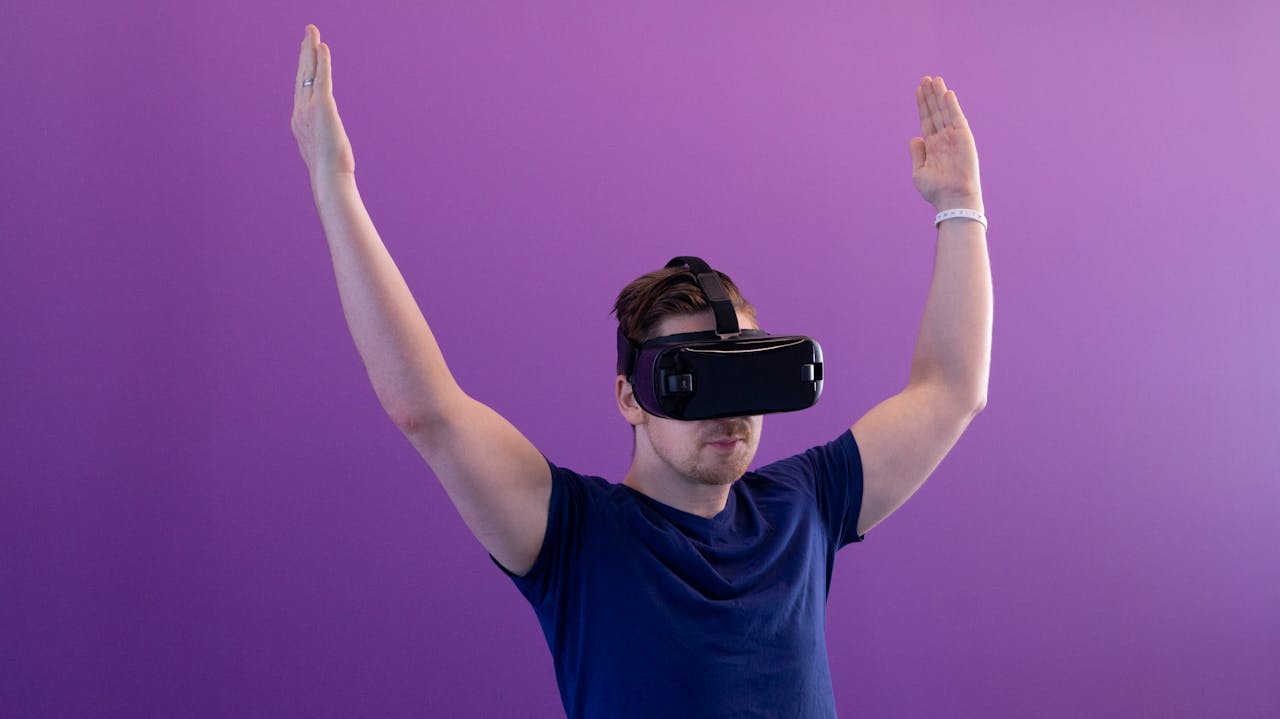Metaverse & Mixed Reality: It’s Not a Game, It’s The Future

Stop Calling It a Game
Your business is probably thinking about the metaverse all wrong.
It’s not a cartoon playground for kids. It’s the next version of the internet. It’s already here. Ignoring the metaverse and mixed reality is like telling people e-commerce was a fad in 1999. A huge, colossal mistake.
The term “metaverse” was coined in Neal Stephenson’s 1992 sci-fi novel Snow Crash, but it took thirty years for the tech to catch up to the fiction. Now, people like Mark Zuckerberg are betting their entire companies on it, calling it a new “embodied internet.” You won’t just look at a screen; you’ll be in the experience.
Forget the abstract definitions. The future of the metaverse is about dissolving the line between digital and physical. And it’s coming faster than you can say “obsolete.”
The Technologies Powering the Metaverse
Everyone thinks this is about goofy headsets. It’s not. The real revolution is a mashup of several powerful technologies finally working together, creating truly immersive experiences.
1—Augmented Reality (AR)
Augmented reality is about adding a digital layer on top of it. Think heads-up displays in your car or those filters that put dog ears on your face.
But it’s getting serious. Companies are using AR for everything from remote assistance to interactive product manuals. It’s the bridge between your physical space and digital information. This isn’t augmented reality vs virtual reality; it’s about using the right tool for the job.
2—Virtual Reality (VR)
VR is the full escape. You put on a headset like the Meta Quest 3 and you’re somewhere else entirely. A different city, a different planet, a fantasy world.
For years, it was a niche for hardcore gamers. Now? It’s a tool for training, therapy, and design. The hardware is still a bit clunky, but it’s getting cheaper and better at a terrifying speed.
3—Mixed Reality (MR)
This is where things get wild. Mixed reality is the ultimate blend. Digital objects don’t just appear in your world—they interact with it. A virtual ball can bounce off your real-world coffee table. A digital blueprint can overlay a physical construction site.
Devices like the Microsoft HoloLens 2 are leading the charge here. The mixed reality applications are insane, from remote surgery to collaborative 3D modeling. It’s the closest thing we have to sci-fi holograms.
4—Artificial Intelligence (AI): The Brains of the Whole Operation
None of this works without AI. It’s the engine that creates realistic virtual worlds, powers intelligent NPCs (non-player characters), and personalizes user experiences on the fly.
The role of AI in metaverse development is everything. As NVIDIA’s CEO Jensen Huang says, AI is the key to building and simulating these complex environments. It’s the ghost in the machine.
5—Blockchain & NFTs: The Ownership Layer
So who owns all the digital crap you buy in the metaverse? Blockchain technology comes in there. It will offer a secure method of keeping information about ownership of digital assets in a decentralized manner.
Some of such digital assets tend to be NFTs (Non-Fungible Tokens). Forget the monkey pictures. The real NFT use cases are about proving you own a virtual piece of land, a unique digital outfit for your avatar, or a ticket to a virtual concert. It’s the foundation for a real, functioning digital economy, as explained by Forbes.
How the Metaverse Will Make (or Break) Your Industry
This isn’t some far-off fantasy. It’s happening now. Industries are being rebuilt, and you’re either on the train or under it. This is the next tech frontier.
1 = Gaming & Entertainment: The Obvious Starting Point
The metaverse in gaming is the low-hanging fruit. If we talk about games, Fortnite and Roblox are already massive social platforms. They host concerts, movie premieres, and brand events. Epic Games is pouring billions into this vision.
But it gets weirder. Think live sports from any angle you choose. Or movies where you can be a character. This is the new playground for media.
2 = Remote Work is Dead, Long Live Virtual Work
Your Zoom calls are about to look ancient. The future of remote work isn’t a 2D grid of faces. It’s a virtual office. You’ll walk up to a colleague’s avatar to chat. You’ll brainstorm on a 3D whiteboard.
Companies are already building these virtual events platforms. It sounds crazy until you realize it solves the biggest problem with remote work: the lack of presence and spontaneous collaboration. Gartner predicts this shift is inevitable.
3 = Education & Training on Steroids
Forget boring textbooks. Imagine medical students practicing surgery on a digital twin of a patient, with zero risk. Or engineers learning to fix a jet engine by taking it apart in a virtual hangar.
These virtual training solutions are ridiculously effective. Osso VR is already a leader in surgical training, proving that immersive learning leads to better outcomes. This will change how we teach and learn forever. A lot of people don’t see it coming.
4 = Healthcare’s Digital Revolution
The potential for healthcare in the metaverse is staggering. We’re talking about VR therapy for PTSD, remote physical therapy sessions, and surgical planning in 3D.
It also offers a new way for doctors to visualize complex medical data. Instead of looking at a 2D scan, a surgeon can walk around a 3D model of a patient’s heart before ever making an incision.
5 = E-commerce and the Virtual Try-On
Online shopping has one big flaw: you can’t try stuff on. The metaverse e-commerce model fixes that. You’ll have a realistic avatar that can try on clothes from any brand, in any size.
Companies like Shopify are already investing heavily in AR to let you see furniture in your room before you buy it. This is the next evolution of retail—a world where you can visit a virtual store in Decentraland just as easily as you can visit Amazon.com.
Why the Metaverse Could Fail Spectacularly
Let’s get real. This whole thing could crash and burn. There are massive, expensive, and complicated problems nobody has solved yet. Forget the hype—here’s the reality check.
A = The Interoperability Nightmare
Right now, the metaverse is a bunch of walled gardens. Your avatar and items from one platform are trapped there. You can’t take your Fortnite skin into a Microsoft workroom. This lack of interoperability standards is a huge problem. As IEEE Spectrum points out, without open standards, it’s not a true metaverse. It’s just a bunch of competing games.
B = Who Owns Your Digital You?
Data privacy in the metaverse is a ticking time bomb. Think about the data being collected: your movements, your speech, even your eye-tracking. Who owns it? How is it being used? The EFF warns this could be a privacy disaster far worse than social media. The metaverse security risks are real and terrifying.
C = The Hardware Isn’t Ready
The hardware for metaverse access is still a barrier. High-end headsets like the Apple Vision Pro cost thousands of dollars. Cheaper ones are often clunky and uncomfortable. Until the hardware becomes as seamless and affordable as a smartphone, mass user adoption metaverse-wide will be a struggle. We’re not there yet. Not even close.
D = The Billion-Dollar Ghost Towns
The biggest risk? What if they build it and nobody comes? We’ve already seen it happen. Companies spend millions on virtual worlds that end up being empty wastelands. Building a cool virtual space isn’t enough. You need a reason for people to show up, and more importantly, to stay.
Your Step-by-Step Escape Plan from Web 2.0
So how do you actually prepare for this without betting the farm on vaporware? It’s simpler than you think. You don’t need to build a metaverse. You just need to get ready for it. This is your future-proof your business plan.
Step 1: Start with 3D Assets
Your brand, your products, your logo—they all need to exist in 3D. Start creating 3D assets now. Whether you hire a designer or learn a tool like Blender, this is the fundamental building block for everything to come. Your flat JPEGs won’t cut it in a 3D world.
Step 2: Experiment with AR
You don’t need a massive budget. Start small with augmented reality marketing. Design an Instagram filter. Put a QR code on your packaging and open an AR experience. Make customers see what your product would look like at home with the help of their phone. Harvard Business Review has demonstrated evidence of how successful this can become. It is a cost effective method to simply put your toe in the water.
Step 3: Protect Your Digital Real Estate
Just like you bought a domain name in the 90s, you should claim your brand’s name and space in major virtual worlds. Look at platforms like The Sandbox or Decentraland. Buying a plot of virtual real estate might seem silly now, but you’ll be glad you did when digital land is the new beachfront property.
Step 4: Foster a Community
The metaverse is social. It’s about connection. The most successful metaverse projects are built around passionate communities. Start building online communities now on platforms like Discord. Give your fans a place to connect with you and each other. This is the audience that will follow you into the metaverse.
Final Words: The Future is Here, and It’s Weird as Hell
The metaverse is not a sure utopia. It is dirty, unclear and hyped. But it’s also the next logical step in our digital transformation. The line between our physical and digital lives is dissolving.
The market is projected to be worth trillions, according to analysts at Bloomberg. It’s currently sliding down the Gartner Hype Cycle, but that’s when the real building begins.
You can sit on the sidelines and watch it happen, or you can grab a paddle and start rowing.
Your call.
FAQs
Is the metaverse mixed reality?
Nope. The metaverse is the world. Mixed reality is the doorway.
What does mixed reality mean in Meta?
Real and fake collide. You see your room, but it’s got digital stuff floating in it.
What’s the future of mixed reality?
No wires. No clunky gear. Just digital layers on your life. Everywhere.
What’s the difference between mixed and virtual reality?
Virtual = fake world. Mixed = real world + fake stuff added in.
Examples of mixed reality?
A surgeon sees your bones in 3D. A gamer fights monsters in their kitchen. An engineer walks through a building that doesn’t exist yet.
When did the metaverse start?
The name? 1992. The hype? 2021, when Zuck changed Facebook’s name.






